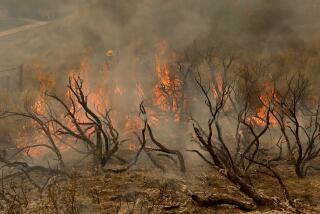Editorial: When fire season lasts all year long
The devastating Carr fire in Northern California continues to ravage the countryside, nearing — if not already surpassing — 100,000 acres, destroying at least 874 buildings and, even more tragically, killing six people with an additional seven people unaccounted for. To the southeast, two men — one a firefighter and the other a bulldozer operator — died fighting the 57,000-acre Ferguson fire near Yosemite National Park. There were 15 other fires raging elsewhere in California, including two fresh fires forcing evacuations in Mendocino and Lake counties. And it’s not just California that’s burning. As of Monday morning, at least 90 large fires were reported nationwide, all in the West except for a blaze in Florida.
Such fires are nothing new in this part of the country. But the fire season this year has begun much earlier than usual, and while scientists warn that specific weather conditions cannot be tied directly to climate change, these are just the sorts of impacts we have been warned to expect from a warming planet.
For the record:
9:25 a.m. July 31, 2018An earlier version of this editorial incorrectly referred to a mudslide this year in Mendocino. The debris flow was in Montecito.
In fact, prolonged drought is a major factor in the current fires. Years of drought, broken by a rainy 2016-2017 winter followed by an unusually dry winter last year, have left the countryside covered with dead or dormant plants. In the mountains, drought damage has been augmented by bark beetle infestations that have left more than 100 million trees dead on their roots in California alone. All of that organic material is kindling and fuel for an errant spark or a bolt of lightning. And if heavy rains come in the aftermath of a fire, the charred landscape becomes the setting for deadly mudslides like those that flowed through Montecito earlier this year.
As the world continues to burn fossil fuels, and climate change becomes more pronounced, we have to recognize that this isn’t nature just doing its thing.
The loss of life has been heartbreaking. Three of the Carr fire victims were 70-year-old Melody Bledsoe and two great-grandchildren who perished near Redding as a wall of flames sped through their neighborhood. In the Sierra Nevada, 33-year-old Brian Hughes, a “hotshot” firefighter, died when he was struck by a falling tree as he and colleagues raced to set a backfire to stanch the Ferguson fire. Firefighters found another unidentified body Sunday in the ashes of a different home near Redding, and it seems likely that more remains will be found elsewhere in the days to come.
Few areas of the state are immune from wildfires, and no Californian can shake the sense as we watch the smoke and rising death counts that there but for the grace of the prevailing winds go I. We know what we’re supposed to do: Maintain brush-free areas around homes in fire-prone areas, have an escape plan laid out, resist the urge for heroics and flee when authorities say so. But as the world continues to burn fossil fuels for energy, and climate change becomes more pronounced, we have to recognize that this isn’t nature just doing its thing. We have through our actions endangered ourselves, a reality we must recognize and rectify as quickly and forcefully as possible.
Enter the Fray: First takes on the news of the minute from L.A. Times Opinion »
Part of the responsibility falls on state and local officials, who must deal with the rising cost of fire prevention and suppression. State lawmakers recently began hammering out a more balanced approach to assigning liability when power lines cause a fire. Under current law, homeowners can collect from utilities even if the utilities were not negligent. With the state’s fiery future, that’s likely to lead to financial ruin for the power companies. Local planners and developers can also do more to consider wildfire risks as they make land-use decisions, and we need to adopt policies that make it easier to develop urban areas at higher levels of density.
But such moves only help address the impacts of the wildfires and mudslides. To get at the root of the problem we must more radically reduce our dependence on fossil fuels for energy and transportation. The Trump administration’s “burn, burn, burn” approach to fossil fuel is no help on that front. The evidence of the horrible impacts is right before the nation’s eyes, yet the administration is looking at ways it can undo California’s efforts to reduce carbon emissions from motor vehicles.
At the moment, there is mourning to be done over the lives lost in the current conflagrations, and there are fires to be contained as well as damage to be assessed and dealt with. But we also must not lose sight of the fact that we can mitigate some of the dangers we face in the future by acting now. We just need the political will to do so.
Follow the Opinion section on Twitter @latimesopinion or Facebook
More to Read
A cure for the common opinion
Get thought-provoking perspectives with our weekly newsletter.
You may occasionally receive promotional content from the Los Angeles Times.










